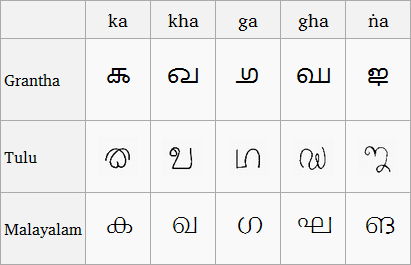General Knowledge about Tulu Language
Tulu is one of the five major Dravidian languages, however it is lesser known to us in comparison to the other four viz. Tamil, Telugu, Kannada and Malayalam. While the four major languages spoken dominantly in their respective states (Tamilnadu, Andhra Pradesh, Karnataka and Kerala), Tulu is spoken in a small region, mainly in coastal Karnataka and Northern Kerala, known as Tulu Nadu.
Script
Modern day Tulu literature is written using the Kannada script. Tulu was originally written using the Tulu script which is known as Arya elzuttu. At the beginning of the 20th century the practice of writing Tulu in Tulu script faced a decline and was gradually abandoned in favour of the Kannada script. Recently attempts were made to revive the original Tulu script. Karnataka Tulu Sahitya Acadamy has prepared a standard Tulu Script by comparing different types of manuscripts. Since 2010 Tulu is being taught as a subject at the higher primary level of education in Coastal Karnataka.
Literature
The written literature of Tulu is not as large as the literature of other literary Dravidian languages.
- The earliest available Tulu literature that survives to this date is the Tulu Translation of the great Sanskrit epic of Mahabharata called Tulu Mahabharato, written by Arunabja around late 14th to early 15th century AD.
- Other important literary works in Tulu are: Sri Bhagavata, Kaveri, Devi Mahatmyam’s Tulu Translation.
- Mandara Ramayana by Mandara Keshava Bhatt is the most notable piece of modern Tulu literature.
Oral traditions
Pad-danas:
- A form of oral Epic poem sung in a highly stylised manner during the Hindu rituals of Bhuta Kola and Nagaradhane, which are peculiar to the Tulu people.
- These paddanas are mostly legends about gods or historical personalities among the people.
- The most important of them is Siri Paddana, which is about a woman called Siri who shows strength and integrity during adverse times and in turn attains divinity.
- Under the Pad-danas label there are at least two distinct, major traditions: Pad-danas and Sandhis. Usually, Tulu folk researchers associated pad-danas with the singing of epics of spirit deities and sandhis to the singing of epics relating to occupation, agriculture, kinship, and so on.
Riddles:
- These riddles are largely tongue twisting and mostly deal with kinship and agriculture.
Bhajans:
- Bhajans sung in numerous temples across the Tulu region are varied and are dedicated to various gods and goddesses. Most of them being of Hindu tradition, others being Jain.
- They are sung in both the Carnatic style as well a style similar to what is used in Yakshagana
Kabitol:
- Sung during cultivation of crops, the traditional occupation of the people.
- Bele is the finest among the Kabitol.
Karnataka Tulu Sahitya Academy has planned to document Tulu pad-danas, sandhis (sung narratives from folk epics), and bhoota kolas (a ritual of worshipping spirit deities) in audio-visual form and preserve them.
Theatre and films
Plays
Tulu plays are among the major entertainment for admirers of art and culture in the Tulu Nadu. Tulu plays generally centered on the comic genre are very popular in Mumbai and Bangalore outside Tulu Nadu.
Yakshagana
 Yakshagana is a theatre form that combines, dance, music, dialogue, costume, make-up and stage techniques with a unique style and form.
Yakshagana is a theatre form that combines, dance, music, dialogue, costume, make-up and stage techniques with a unique style and form.- This theatre style is mainly played in the coastal districts of Karnataka and northern Kerala.
- Yakshagana has greatly preserved the finer aspects of the Tulu language.
Tulu films
- Tulu film industry is pretty small and it produces 2 to 3 films annually.
- The first film, Enna Thangadi, was released in 1971.
- The critically acclaimed Film Suddha, won the award for the best Indian Film at the Osian film festival held at New Delhi in 2006.
Oriyardori Asal released in 2011 is the most successful Tulu film till date.
(image: wikimedia commons)


